Page 229 of 498
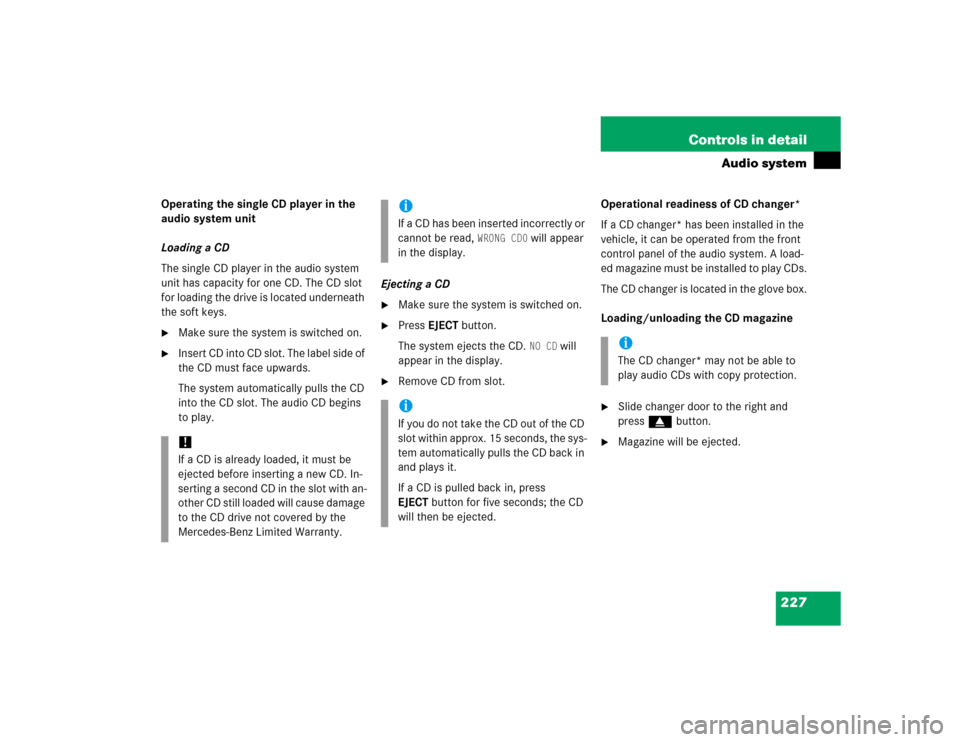
227 Controls in detail
Audio system
Operating the single CD player in the
audio system unit
Loading a CD
The single CD player in the audio system
unit has capacity for one CD. The CD slot
for loading the drive is located underneath
the soft keys.�
Make sure the system is switched on.
�
Insert CD into CD slot. The label side of
the CD must face upwards.
The system automatically pulls the CD
into the CD slot. The audio CD begins
to play.Ejecting a CD
�
Make sure the system is switched on.
�
Press EJECTbutton.
The system ejects the CD.
NO CD
will
appear in the display.
�
Remove CD from slot.Operational readiness of CD changer*
If a CD changer* has been installed in the
vehicle, it can be operated from the front
control panel of the audio system. A load-
ed magazine must be installed to play CDs.
The CD changer is located in the glove box.
Loading/unloading the CD magazine
�
Slide changer door to the right and
press gbutton.
�
Magazine will be ejected.
!If a CD is already loaded, it must be
ejected before inserting a new CD. In-
serting a second CD in the slot with an-
other CD still loaded will cause damage
to the CD drive not covered by the
Mercedes-Benz Limited Warranty.
iIf a CD has been inserted incorrectly or
cannot be read,
WRONG CD0
will appear
in the display.
iIf you do not take the CD out of the CD
slot within approx. 15 seconds, the sys-
tem automatically pulls the CD back in
and plays it.
If a CD is pulled back in, press
EJECTbutton for five seconds; the CD
will then be ejected.
iThe CD changer* may not be able to
play audio CDs with copy protection.
Page 232 of 498
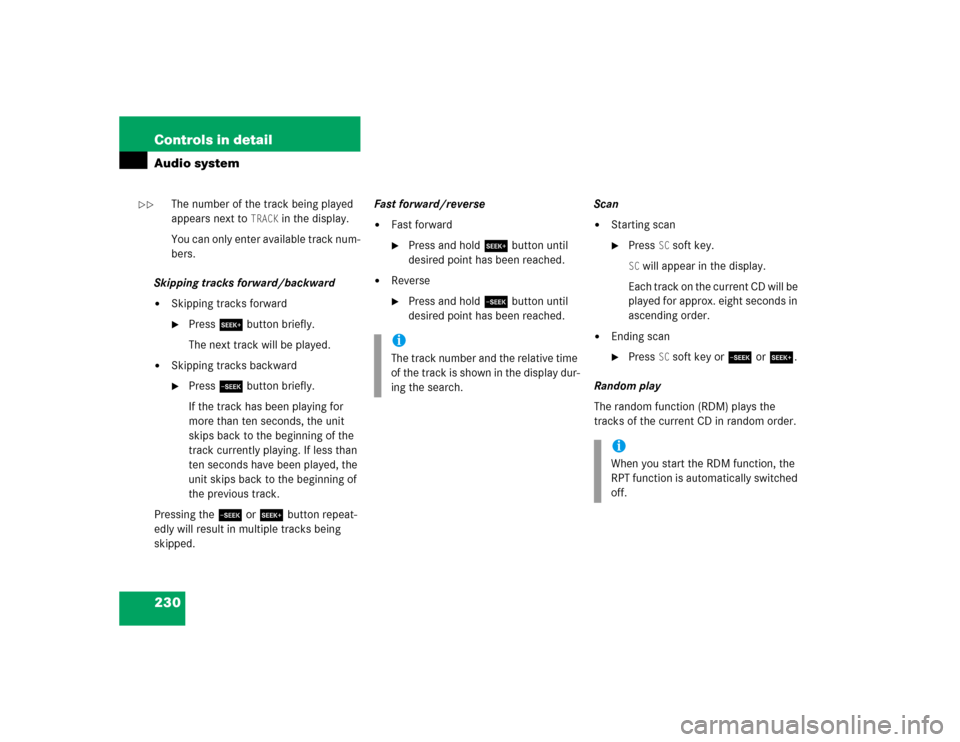
230 Controls in detailAudio system
The number of the track being played
appears next to
TRACK
in the display.
You can only enter available track num-
bers.
Skipping tracks forward/backward
�
Skipping tracks forward�
Press S button briefly.
The next track will be played.
�
Skipping tracks backward�
Press T button briefly.
If the track has been playing for
more than ten seconds, the unit
skips back to the beginning of the
track currently playing. If less than
ten seconds have been played, the
unit skips back to the beginning of
the previous track.
Pressing the T or S button repeat-
edly will result in multiple tracks being
skipped.Fast forward/reverse
�
Fast forward�
Press and hold S button until
desired point has been reached.
�
Reverse�
Press and hold T button until
desired point has been reached.Scan
�
Starting scan�
Press
SC soft key.
SC will appear in the display.
Each track on the current CD will be
played for approx. eight seconds in
ascending order.
�
Ending scan�
Press
SC soft key or T or S.
Random play
The random function (RDM) plays the
tracks of the current CD in random order.
iThe track number and the relative time
of the track is shown in the display dur-
ing the search.
iWhen you start the RDM function, the
RPT function is automatically switched
off.
��
Page 233 of 498
231 Controls in detail
Audio system
�
Switching on random�
Press
RDM
soft key.
RDM
appears in the display. A ran-
domly selected track is played.
�
Switching off random�
Press
RDM
soft key again.
Repeat
The track being played is repeated until the
repeat function is switched off.
�
Switching on repeat�
Press
RPT
soft key.
RPT appears in the display.
�
Switching off repeat�
Press
RPT
soft key again.
Pause function
The CD changer mode is interrupted by an
incoming call on the telephone*
(
�page 237).
�
Switching on pause function�
Press U button.
The CD changer mode is interrupt-
ed and
PAUSE
appears in the dis-
play.
�
Switching off pause function�
Press U button.
The CD changer mode is active
again.
iWhen you start the RPT function, the
RDM function is automatically
switched off.
Page 234 of 498
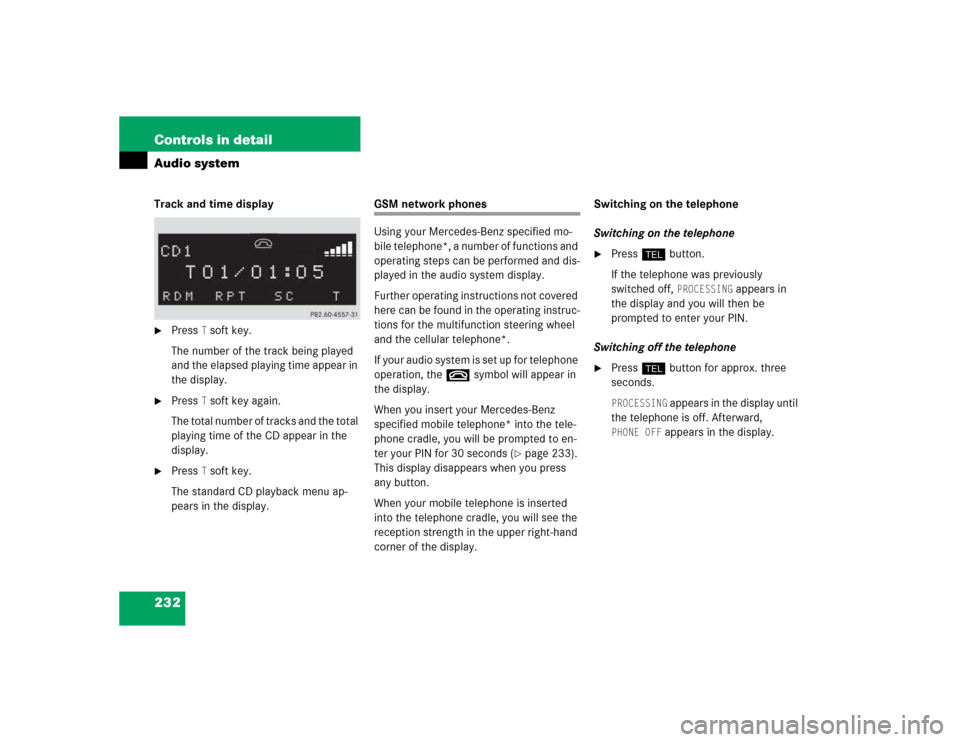
232 Controls in detailAudio systemTrack and time display�
Press
T soft key.
The number of the track being played
and the elapsed playing time appear in
the display.
�
Press
T soft key again.
The total number of tracks and the total
playing time of the CD appear in the
display.
�
Press
T soft key.
The standard CD playback menu ap-
pears in the display.
GSM network phones
Using your Mercedes-Benz specified mo-
bile telephone*, a number of functions and
operating steps can be performed and dis-
played in the audio system display.
Further operating instructions not covered
here can be found in the operating instruc-
tions for the multifunction steering wheel
and the cellular telephone*.
I f y o u r a u d i o s y s t e m i s s e t u p f o r t e l e p h o n e
operation, the tsymbol will appear in
the display.
When you insert your Mercedes-Benz
specified mobile telephone* into the tele-
phone cradle, you will be prompted to en-
ter your PIN for 30 seconds (
�page 233).
This display disappears when you press
any button.
When your mobile telephone is inserted
into the telephone cradle, you will see the
reception strength in the upper right-hand
corner of the display.Switching on the telephone
Switching on the telephone
�
Pressh button.
If the telephone was previously
switched off,
PROCESSING
appears in
the display and you will then be
prompted to enter your PIN.
Switching off the telephone
�
Pressh button for approx. three
seconds.PROCESSING
appears in the display until
the telephone is off. Afterward,
PHONE OFF
appears in the display.
Page 235 of 498
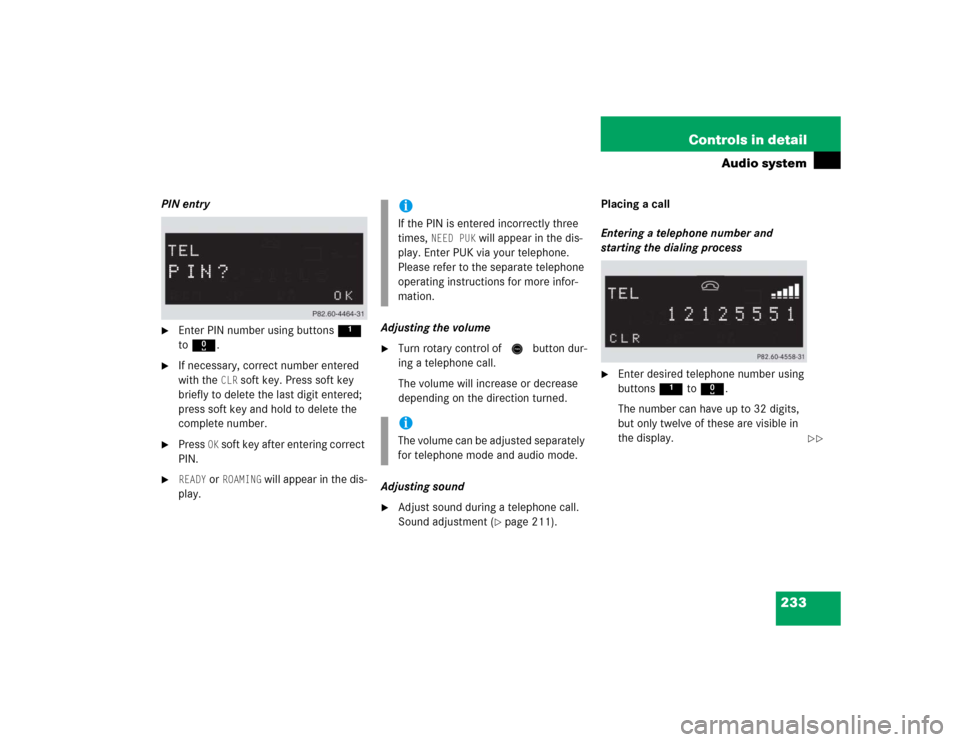
233 Controls in detail
Audio system
PIN entry�
Enter PIN number using buttons 1
to R.
�
If necessary, correct number entered
with the
CLR
soft key. Press soft key
briefly to delete the last digit entered;
press soft key and hold to delete the
complete number.
�
Press
OK soft key after entering correct
PIN.
�
READY
or
ROAMING
will appear in the dis-
play.Adjusting the volume
�
Turn rotary control of N button dur-
ing a telephone call.
The volume will increase or decrease
depending on the direction turned.
Adjusting sound
�
Adjust sound during a telephone call.
Sound adjustment (
�page 211).Placing a call
Entering a telephone number and
starting the dialing process
�
Enter desired telephone number using
buttons 1 to R.
The number can have up to 32 digits,
but only twelve of these are visible in
the display.
iIf the PIN is entered incorrectly three
times,
NEED PUK
will appear in the dis-
play. Enter PUK via your telephone.
Please refer to the separate telephone
operating instructions for more infor-
mation.
iThe volume can be adjusted separately
for telephone mode and audio mode.
��
Page 236 of 498
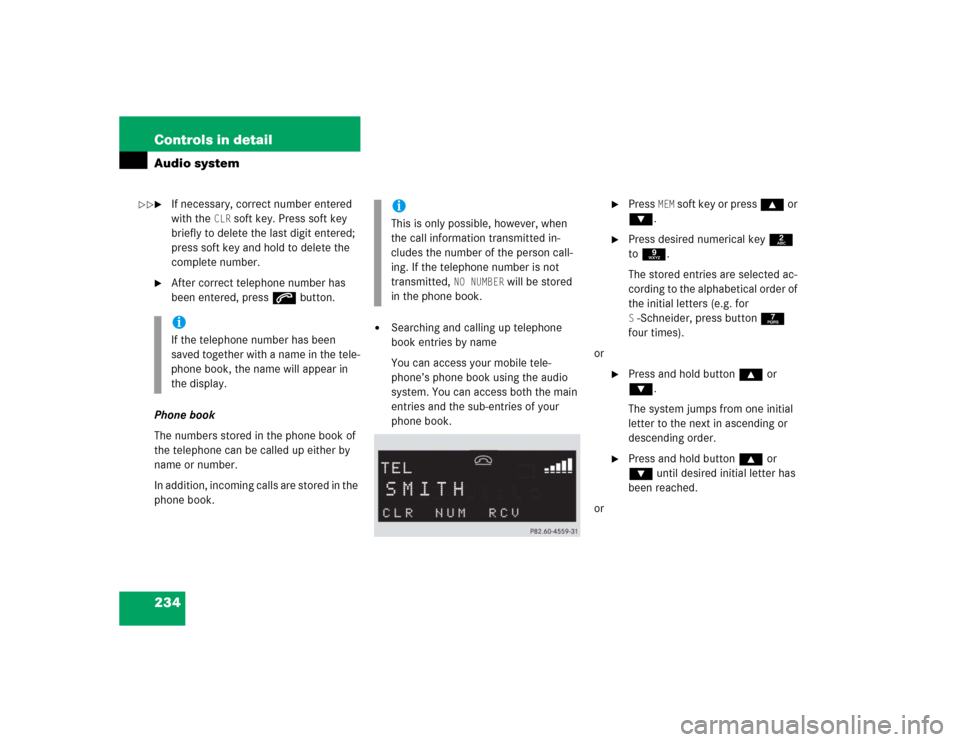
234 Controls in detailAudio system�
If necessary, correct number entered
with the
CLR
soft key. Press soft key
briefly to delete the last digit entered;
press soft key and hold to delete the
complete number.
�
After correct telephone number has
been entered, press s button.
Phone book
The numbers stored in the phone book of
the telephone can be called up either by
name or number.
In addition, incoming calls are stored in the
phone book.
�
Searching and calling up telephone
book entries by name
You can access your mobile tele-
phone’s phone book using the audio
system. You can access both the main
entries and the sub-entries of your
phone book.
�
Press
MEM
soft key or press ‚ or
ƒ.
�
Press desired numerical key 2
to 9.
The stored entries are selected ac-
cording to the alphabetical order of
the initial letters (e.g. for S-Schneider, press button 7
four times).
or
�
Press and hold button ‚ or
ƒ.
The system jumps from one initial
letter to the next in ascending or
descending order.
�
Press and hold button ‚ or
ƒ until desired initial letter has
been reached.
or
iIf the telephone number has been
saved together with a name in the tele-
phone book, the name will appear in
the display.
iThis is only possible, however, when
the call information transmitted in-
cludes the number of the person call-
ing. If the telephone number is not
transmitted,
NO NUMBER
will be stored
in the phone book.
��
Page 237 of 498
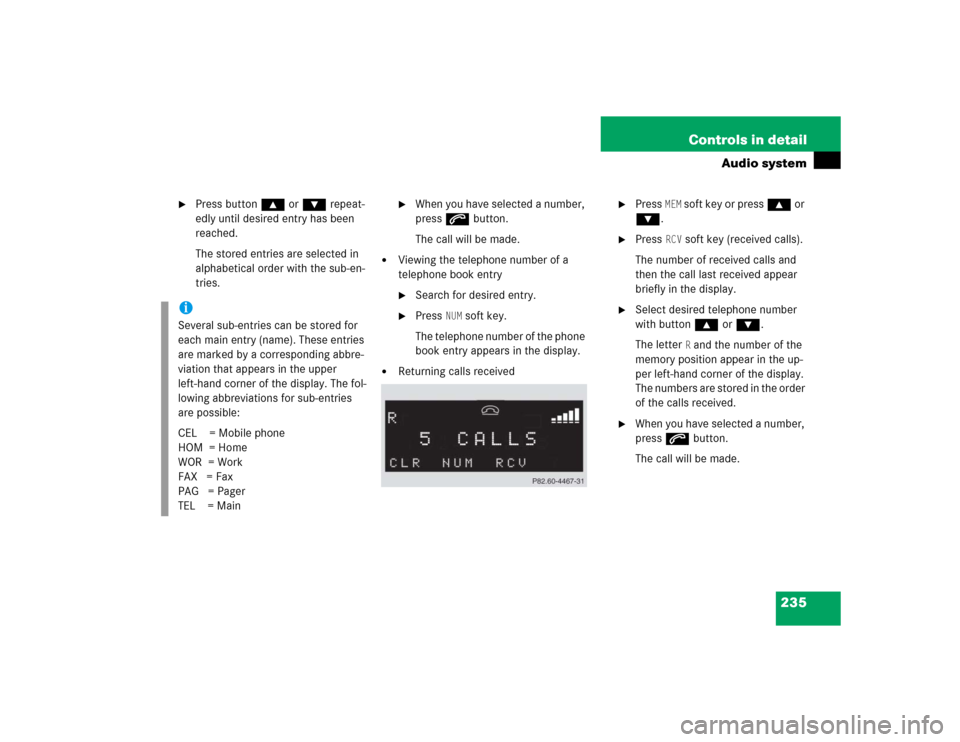
235 Controls in detail
Audio system
�
Press button ‚ or ƒ repeat-
edly until desired entry has been
reached.
The stored entries are selected in
alphabetical order with the sub-en-
tries.
�
When you have selected a number,
press s button.
The call will be made.
�
Viewing the telephone number of a
telephone book entry�
Search for desired entry.
�
Press
NUM
soft key.
The telephone number of the phone
book entry appears in the display.
�
Returning calls received
�
Press
MEM
soft key or press ‚ or
ƒ.
�
Press
RCV
soft key (received calls).
The number of received calls and
then the call last received appear
briefly in the display.
�
Select desired telephone number
with button ‚ or ƒ.
The letter
R and the number of the
memory position appear in the up-
per left-hand corner of the display.
The numbers are stored in the order
of the calls received.
�
When you have selected a number,
press s button.
The call will be made.
iSeveral sub-entries can be stored for
each main entry (name). These entries
are marked by a corresponding abbre-
viation that appears in the upper
left-hand corner of the display. The fol-
lowing abbreviations for sub-entries
are possible:
CEL = Mobile phone
HOM = Home
WOR = Work
FAX = Fax
PAG = Pager
TEL = Main
Page 239 of 498

237 Controls in detail
Audio system
Accepting an incoming call
If the telephone is active in the background
(reception symbol is visible in the display),
the audio source is muted when an incom-
ing call is received. A ringing tone can be
heard and the caller’s telephone number,
or the name under which the telephone
number has been saved in the phone book,
appears in the display. If the caller’s num-
ber is not transmitted with the call,
CALL
will appear in the display.
�
Press s button.
The call is accepted.Muting a call
It is possible to mute a call; the caller is
then no longer able to hear you.
�
Mute on�
Press
MUT
soft key.
�
MIC MUTE
will appear in the display.
�
Mute off�
Press
MUT
soft key again.
Terminating a call
�
Press t button.
The current call is terminated and the
muted audio source becomes active
again.Talking with two callers at the same
time
If you wish to receive or place another call
during an already active call, you can ac-
cept or place the second call and switch
between the callers or combine them into
one call. Note that the features described
here are depending on availability from
your mobile phone service provider.
�
Placing/accepting a second call�
Place new call by entering tele-
phone number manually.
�
Press s button.
You are connected to the second
caller; the first caller is kept on
hold.
or
��